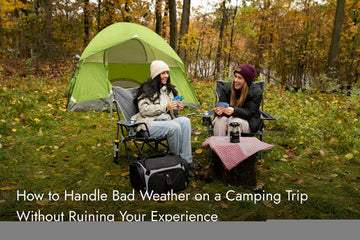Camping in Bad Weather: Tips to Stay Enjoyable | Geckobrands

Camping is an incredible way to connect with nature, but it doesn’t always come with sunny skies and gentle breezes. Rain, wind, and extreme temperatures can turn an anticipated getaway into a soggy, chilly, or sweltering ordeal. But here’s the thing: bad weather doesn’t have to ruin your camping trip. With a little preparation, the right gear, and a positive attitude, you can turn even the stormiest days into memorable adventures.
In this blog, we’ll discuss practical strategies for coping with bad weather while camping, from essential gear to layering techniques and mental tricks to keep your spirits high.
Gear Up for Success: Essentials for Bad Weather
Let’s be honest: the right gear can mean the difference between a miserable experience and a story you can’t wait to tell your friends. Here’s what should be in your arsenal:
1. A Reliable Tent
Your tent is your fortress against the elements. Look for one that’s ready for anything:
-
Waterproof Material: A rainfly and sealed seams are must-haves.
-
Sturdy Poles: Aluminum poles are far better at handling wind than fiberglass ones.
-
Good Ventilation: Keeps condensation at bay and keeps your sleeping space fresh.
Pro Tip: Always set up your tent on high ground—because waking up in a puddle is not part of the camping dream.
2. Weather-Appropriate Clothing
The secret to staying comfortable? Layers. Use this tried-and-true three-layer system:
-
Base Layer: Wicks sweat away (synthetic or merino wool are ideal).
-
Insulating Layer: Traps heat to keep you warm (think fleece or down).
-
Outer Layer: To shield you from the elements (waterproof and windproof are your best bet).
And don’t forget extra socks and gloves. Trust me, there’s no such thing as too many dry socks when the rain won’t quit.
3. Durable Footwear
Wet trails can be a recipe for slips and soaked feet. A solid pair of waterproof boots with good traction will keep you steady and dry.
4. A Quality Sleeping Bag
Choose a sleeping bag with the right temperature rating for your trip. Synthetic insulation is a lifesaver if rain is in the forecast—it retains warmth even when damp.
5. Rain Gear
A good rain poncho, waterproof pants, and pack covers will ensure that neither you nor your gear gets drenched.
Tips for Dealing with Rain
Rain is inevitable at some point in your camping career, but it doesn’t have to dampen your fun. Here’s how to make the most of it:
-
Set Up a Dry Zone: Use a tarp to create a rain-free area for cooking, eating, or just relaxing.
-
Choose Quick-Dry Materials: Opt for synthetic clothes and towels that dry fast and won’t weigh you down when wet.
-
Store Firewood Smartly: Keep firewood in waterproof bags or stash it under a tarp so you can still enjoy a cozy campfire.
-
Turn It Into an Adventure: Play card games, share ghost stories, or listen to the rain while snug inside your tent. Sometimes, it’s the rainy days that bring the most laughter.
Strategies for Handling Wind
Wind can be unsettling—or downright dangerous—if you’re unprepared. Tame the gusts with these tips:
-
Secure Your Tent: Anchor your tent with extra stakes. If you’re expecting strong winds, check your setup twice.
-
Pick Your Campsite Wisely: Set up in a sheltered spot, like behind a line of trees or a rock formation. Avoid exposed areas like ridgelines.
-
Keep Your Gear Grounded: Store loose items inside your tent or weigh them down so they don’t blow away.
-
Dress for the Chill: Wind can make even mild temperatures feel freezing. Layer up with windproof clothing to stay warm.
Coping with Extreme Temperatures
Cold Weather Camping
-
Stay Warm at Night: Use an insulated sleeping pad to block the cold from the ground. A liner inside your sleeping bag adds an extra layer of warmth.
-
Eat Hearty Meals: Fuel your body with high-calorie foods to generate heat.
-
Move Around: Light exercise, like jumping jacks, can help you warm up.
-
Pro Tip: Tuck a hot water bottle into your sleeping bag before bed for a cozy night.
Hot Weather Camping
-
Hydrate, Hydrate, Hydrate: Bring plenty of water and electrolyte tablets to stay hydrated.
-
Find Shade: Set up a tarp or use natural shade to create a cool spot to relax.
-
Cool Off Smartly: Wet a bandana and place it on your neck or head to regulate body temperature.
-
Adjust Your Schedule: Save strenuous activities for early morning or late evening when it’s cooler.
Mental Tricks to Stay Positive
When the weather turns, your mindset can make or break the experience. Here’s how to keep spirits high:
-
Embrace the Adventure: Bad weather adds an element of challenge—and a great story for later.
-
Be Flexible: Adjust your plans to suit the conditions. A long hike can become a cozy day by the campfire.
-
Find Small Joys: A warm meal, a break in the rain, or a gorgeous stormy sky can turn your day around.
-
Bond with Your Crew: Share laughs, play games, and create memories. Bad weather can bring people closer together.
FAQs About Camping in Bad Weather
What if my gear gets wet?
-
Dry items as quickly as possible using sunlight, fire, or even body heat.
Is it safe to camp in a thunderstorm?
-
With the appropriate gear, yes! Avoid open spaces, ridgelines, and tall trees. Seek lower ground and stay inside your tent.
How do I keep my tent dry inside?
-
Use a groundsheet under your tent, and avoid touching the walls when it’s wet.
Final thoughts
Bad weather doesn’t have to derail your camping trip. With the right gear, preparation, and attitude, you can turn rain, wind, or extreme temperatures into unforgettable experiences. Challenges often make the best stories, so embrace the unpredictability and enjoy the ride. After all, isn’t that what camping is all about?

